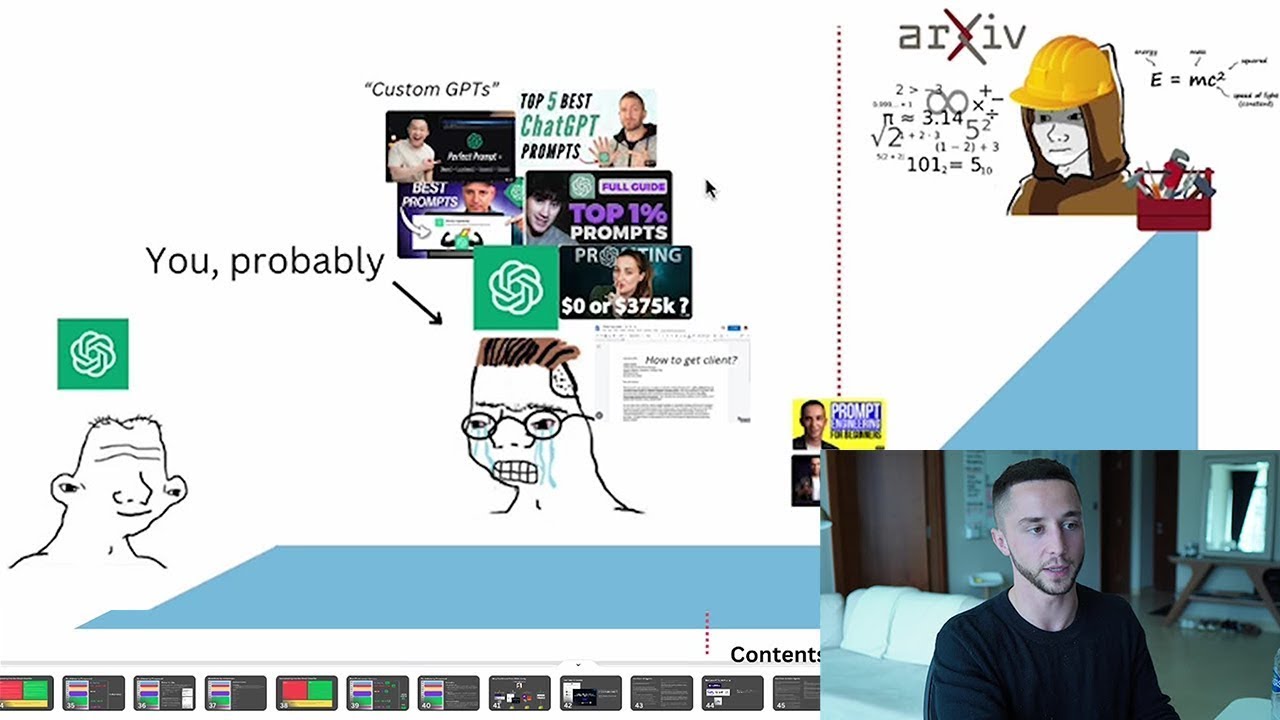26 easy prompt engineering principles for 2024
Summary
TLDRIn this video, Dan from Prompt Tuub explores actionable prompt engineering tips for 2024, drawn from a recent research paper on AI prompting principles. He outlines 26 principles that enhance model performance, focusing on five key categories: specificity, structured prompting, chain of thought reasoning, interactive questioning, and clear instructions over negative prompts. The video highlights practical applications and real-world examples, emphasizing how specific principles, like chain-of-thought reasoning and structured prompts, improve the output quality of models such as GPT-3.5 and GPT-4. Dan also shares a valuable resource for further study, offering a comprehensive table of principle impacts on various models.
Takeaways
- 😀 AI prompt engineering saw significant growth in 2023, with major developments in techniques like Chain of Thought reasoning and few-shot learning.
- 😀 The research paper 'Principled Instructions or All You Need' tested 26 prompting principles to assess their impact on model output quality and correctness.
- 😀 Principled instructions fall into five categories, helping prompt engineers tailor approaches based on their specific use cases (e.g., content creation, conversational AI).
- 😀 Principle 4 emphasizes telling the model exactly what to do, rather than focusing on negative instructions. Positive clarity leads to better model performance.
- 😀 Principle 12 recommends using Chain of Thought reasoning for complex tasks, allowing the model to break down its thought process and generate more accurate results.
- 😀 Principle 19 suggests enabling the model to ask clarifying questions if it needs more information, improving output accuracy and contextual relevance.
- 😀 Using structured prompts with delimiters (e.g., headings and sections) improves clarity, making it easier to understand and work with AI outputs.
- 😀 Few-shot learning, or providing examples in prompts, is essential for guiding models in specific tasks like math, logic, or fact-based queries.
- 😀 Evaluating prompts based on both correctness (accuracy, relevance) and output quality (clarity, fluency) offers a comprehensive measure of performance.
- 😀 Larger models like GPT-4 benefit more from prompt engineering, showing larger improvements in both correctness and output quality compared to smaller models.
- 😀 A comprehensive Google Sheet is available, summarizing the effects of different principles on various models, helping engineers optimize their prompt strategies for GPT-3.5 and GPT-4.
Q & A
What were the key trends in AI prompting that emerged in 2023?
-In 2023, key trends in AI prompting included the development of best practices such as few-shot learning, Chain of Thought (CoT) reasoning, and emotion-driven prompts. These practices helped improve the quality and accuracy of AI responses, especially for complex or logical tasks.
What is the significance of the paper 'Principled Instructions: All You Need' in AI prompt engineering?
-The paper 'Principled Instructions: All You Need' identified 26 principles for improving the quality and correctness of AI outputs. It tested these principles on various datasets and showed their impact on AI model performance, helping to inform best practices for prompt engineering.
How were the principles in the study categorized?
-The 26 prompting principles identified in the study were categorized into five key groups. These categories help users orient their approach based on their specific use case, such as content creation, conversational AI, or logical reasoning tasks.
What is Principle #4, and why is it important?
-Principle #4 advises prompt engineers to focus on telling the model what to do, rather than what not to do. This principle is important because being specific about desired actions leads to better results, whereas negative instructions can sometimes confuse the model.
What is the impact of Chain of Thought reasoning (Principle #12) in prompting?
-Chain of Thought reasoning encourages the model to break down its thought process step by step, which is especially useful for tasks involving complex logic. This structured reasoning helps the model arrive at more accurate and thoughtful responses.
How do delimiters and structured prompts (Principle #26) improve AI responses?
-Delimiters and structured prompts break down the prompt into clear, organized sections, such as instructions, demonstrations, and questions. This structure makes it easier for the model to understand the prompt and produce higher-quality, more accurate outputs.
What was the performance difference between smaller models and larger models in the study?
-The study found that larger models, such as GPT-4, showed significantly better improvements in both response quality and correctness when these principles were applied. Smaller models saw moderate improvements, but the larger models benefited the most from these techniques.
What is the role of few-shot learning in improving AI responses?
-Few-shot learning involves providing the model with a few examples or demonstrations of the desired output. This helps the model better understand the context and expectations, leading to improved responses, particularly in tasks that require reasoning or structured output.
What are the key benefits of using structured prompts with delimiters in AI prompting?
-Structured prompts with delimiters improve clarity and organization, making it easier for both the AI and humans to understand the prompt. This approach leads to better outputs and simplifies collaboration, as the components of the prompt are easily identifiable and modifiable.
How can the results from the study be accessed and used by practitioners?
-The results, including a detailed table showing the impact of different principles on models like GPT-3.5 and GPT-4, can be accessed through the Prompt Tuub Substack. By signing up with an email, users can download a Google Sheet that allows them to filter and explore the data.
Outlines

此内容仅限付费用户访问。 请升级后访问。
立即升级Mindmap

此内容仅限付费用户访问。 请升级后访问。
立即升级Keywords

此内容仅限付费用户访问。 请升级后访问。
立即升级Highlights

此内容仅限付费用户访问。 请升级后访问。
立即升级Transcripts

此内容仅限付费用户访问。 请升级后访问。
立即升级浏览更多相关视频

ChatGPT Tutorial for Beginners in Hindi | Step by Step

why you suck at prompt engineering (and how to fix it)

Episódio 05 - Máquinas e Mentes - Parte II

Prompt Engineering Tutorial: A Beginner's Guide to AI Prompting | OpenAI, Midjourney, Meta AI & More

Prompt Engineering: The Art of Communicating with AI

99% Of People STILL Don't Know The Basics Of Prompting (ChatGPT, Gemini, Claude)
5.0 / 5 (0 votes)
